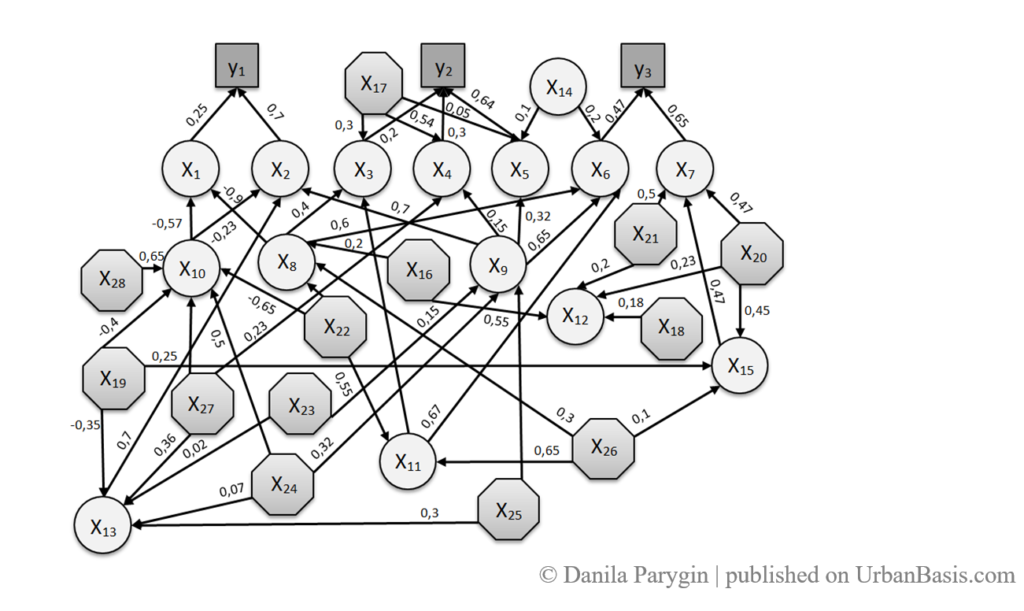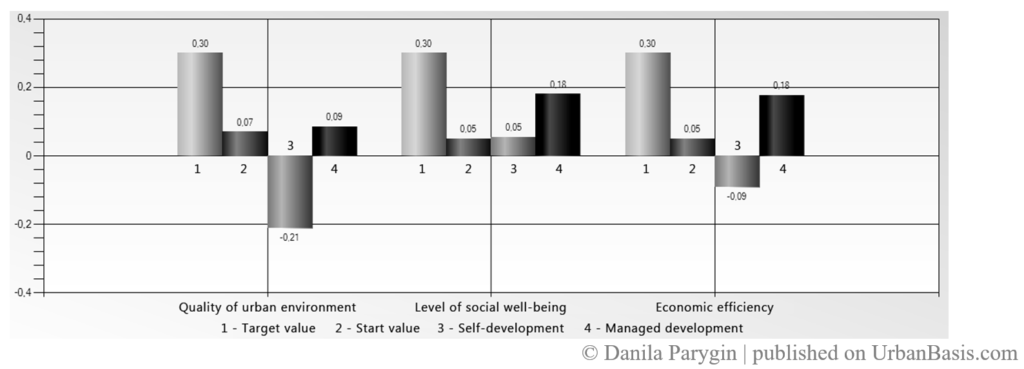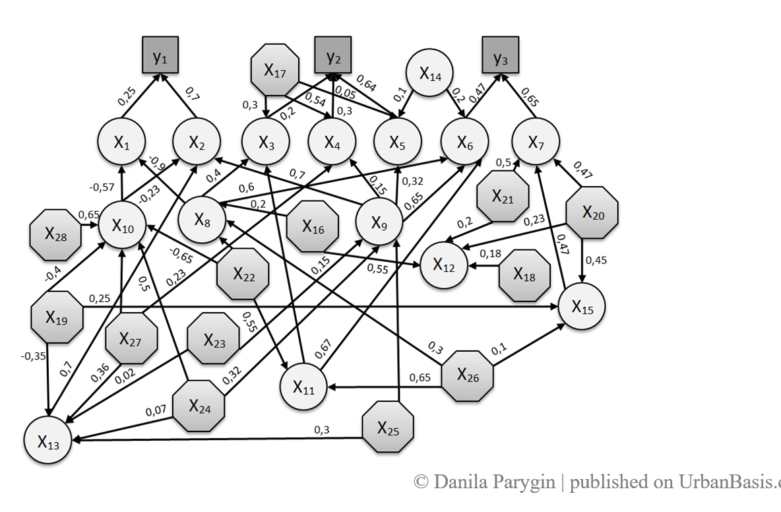Scenario forecasting of sustainable urban development based on cognitive model / N. Sadovnikova, D. Parygin, E. Gnedkova, A. Kravets, A. Kizim, S. Ukustov // ICT, Society and Human Beings 2013 : Proceedings of the IADIS International Conference, Section I, Prague, Czech Republic, 24–26 July 2013. – IADIS Press, 2013. – P. 115–119.
Natalia Sadovnikova
Danila Parygin
Elena Gnedkova
Alla Kravets
Alexey Kizim
Sergey Ukustov
Abstract. Cognitive modeling is used in order to improve decision-making in creating strategies of sustainable urban development. Development scenarios of Volgograd (Russia) are constructed, and different strategies from the perspective of sustainable development are assessed. Features of the city and factors that characterize the current state of the economic, environmental and social issues were taken into account when constructing the cognitive map. The contribution of this part of the research is related to the identification of the interplay of various factors of the sustainable urban development and the inclusion of synergistic and cumulative effects into the analysis.
Keywords: sustainable development, urban planning project, scenario forecasting, fuzzy cognitive maps, evaluation of the strategy.
1 Introduction
Dynamics of the development of modern cities is complex and multifaceted. Scientific understanding of new realities and perspectives and the definition of the principles of forming development strategies is extremely relevant. The purpose of strategic planning should be in creating of a comfortable, safe urban environment, the conditions for self-realization of residents and knowledge economy and unique cultural spaces development. Ideology of sustainable development, which is a shift from the ideas of «regulation environment» to a focused reasonable planning of economic operations, plays a special role in the transformation process of a city. Adoption and implementation of wrong decisions violate the principles of sustainable development and threaten the viability of city. There is the issue of forming an evidence-based approach to decision management solutions on implementation development plans for urban territories. This requires finding the technology to generate and analyze different solutions and evaluate their effectiveness. This paper presents an approach to the analysis of scenarios for the city of Volgograd from the position of sustainable development. Using the methodology of cognitive modeling allows evaluating the effectiveness of decision-making and analyzing dynamics of situation when implementing the different scenarios.
2 Decision making support in tasks of urban planning
The process of urban development planning is associated with the design of strategic decisions. Their implementation provides formation of urban environment taking into account the demographic processes, ecology, resource potential, the needs of the domestic and foreign market, historical and cultural traditions, and identifying perspective directions of investment attracting.
Decisions are made at the strategic level of management principles creation and the operational level during the selection of territory use methods, funds distribution, business environment changes, etc. The task of deciding is formulated as follows: what actions are needed to achieve the set values of the indicators of sustainable development taking into consideration current state and ambient factors. Many works are associated with the development of methodologies of assess the degree of achievement of sustainable development goals (Bossel, 2001). However, they do not solve the problem of possible consequences analysis. This requires the use of a variety of modeling and forecasting methods.
The most famous city model was designed by J. Forrester (Forrester, 1969). It describes the interaction and the development of three subsystems: population, housing and businesses, and allows to predict urban development and analyze various managing impacts options. Modern approaches for the use of simulation modeling in solving problems management of social-economic systems are offered in works of scientists (Lychkina, 2012; Putilov, 2002; Katalevsky, 2011). In many cases, the method does not allow accurate estimating of the future states of the system. This happens because of the lack of a mechanism integrating qualitative changes and uncertainties. This paper proposes to use the methodology of scenario forecasting based on fuzzy cognitive maps for support of decision-making in the creation of urban development strategy.
2.1 Sustainable urban development and sustainable development criteria
Sustainable urban development provides safety and high life quality while preserving natural environment, resources and ecological balance. It is the primary criterion of management policy efficiency. Charter of European Cities & Towns Towards Sustainability states that «as each city is different, we have to find our individual ways towards sustainability. We shall integrate the principles of sustainability in all our policies and make the respective strengths of our cities … the basis of locally appropriate strategies» (Charter, 1994).
Developing strategic plans for urban development is carried out under conflict of different communities and activities. Consideration of stakeholders interests is a necessary condition for efficient management and a possible step toward finding the most balanced development strategy. Stakeholder groups are determined by the mission of the city. The mission shows the main purpose of the city and its role in the region, the country and the international community, a place in the social division of labor, the competitive advantages that provide attractive to people. In this case stakeholders include not only persons vesting the power to influence achievement of the objectives, but also those who may be affected directly or indirectly by the result of the proposed activity. Table 1 presents the objectives defining interests of various target groups, the possible managing impacts that can be used to influence and indicators to assess degree of achievement of objectives.
Table 1. Target set of stakeholders, possible managing impacts, indicators of sustainable development
| Goals | Managing impacts | Indicators of sustainable development |
| Formation of favorable business climate | Commissioning new productions Activities to attract investment Changes in tax legislation Introduction of incentives for small business Investments in development of industry/small business Investments in knowledge sector Development of high-tech economy sector | Economic efficiency |
| Formation of favorable social climate | Increase in social payments Commissioning of new social facilities Formation of public spaces Construction of social housing Reorganization of governance institutions Measures to increase competitiveness young specialists Extension the scope of information and communication technologies Introduction of mechanisms popularization knowledge Dissemination of principles New Urbanism | Level of social well-being |
| Improving urban environment | Construction of housing Infrastructure development Urban transport development Introduction of environmental taxes Increase fines for violations of environmental laws Introduction of benefits system for energy efficient facilities Reduced operating costs through the introduction of new technologies Development green areas Introduction of green building technologies and transit-oriented design Creation mechanisms to stimulate and promote healthy lifestyles | Quality of urban environment |
2.2 Construction cognitive model
The methods of fuzzy cognitive analysis and scenario modeling will be used to analyze the possible management strategies. Uncertainty of factors and their relationships is the feature of the application of cognitive modeling to complex systems behavior identification. Values of the factors are most often represented as linguistic variables and interval estimates. Model structure can be changed during the study.
The modeled situation is described by fuzzy cognitive maps (Kosko, 1986), which are weighted oriented graphs of cause-effect relationship that illustrate multiple links between the system factors, such as human factors, nature protection activity and environment components. These maps are useful for identifying and representing the second-order effects (indirect, etc.). Further, the method of pulse processes (Roberts, 1986), which falls under the category of dynamic methods, is used to obtain a forecast of development. Pulse process allows to determine concept state in discrete time. Analyzing the state allows experts to receive a forecast of system state changes at realization of various management strategies and ambient changes.
The official data of the Federal State Statistics Service of Russia, the materials General Development Plan of Volgograd, the Strategic Plan, the Investment Passport of Volgograd (FSSS, 2013; Volgadmin, 2013) served as initial information for model construction. The system «Strategist», developed at the Department CAD of VSTU (Zabolotskiy, 2008) and based on the methodology presented in the paper (Kulba, et al, 2004; Maksimov, 2005), was used to carry out cognitive analysis.
Basic factors selected to characterize urban development are shown in table 2. Cognitive map of sustainable development of Volgograd is represented in Figure 1. According to the sustainable development objectives the observed factors are the quality of urban environment (y1), the level of social well-being (y2) and economic efficiency (y3). The managers: x16,…,x28 are allocated from the set of basic factors that directly or indirectly affect the situation development. We can change their values using managing impacts.
Table 2. Initial change trends factors affecting the sustainable development
| Designation | Name of factor | The initial trend | Changing the initial trend of factors |
| x1 | Physical comfort level | –0,2 | |
| x2 | Environmental safety level | –0,1 | |
| x3 | Psychological comfort level | –0,2 | |
| x4 | Consumption level | 0,2 | |
| x5 | Social safety level | –0,1 | |
| x6 | Competitiveness of territory | 0,1 | |
| x7 | Resource efficiency | –0,2 | |
| x8 | Public spaces development level | 0 | |
| x9 | Infrastructure development level | 0,1 | |
| x10 | General emission status | 0 | |
| x11 | Aesthetic appeal of territory | –0,2 | |
| x12 | Biospheric-compatibility level | 0 | |
| x13 | Environmental load | 0,1 | |
| x14 | Provision of labor resources | 0 | |
| x15 | Effectiveness use of territory | –0,1 | |
| x16 | Proportion of green territories recreational purpose | 0 | 0,3 |
| x17 | Material well-being level | 0,1 | 0,2 |
| x18 | Proportion of «green» objects | 0 | 0,1 |
| x19 | Proportion of recycled waste | 0 | 0,2 |
| x20 | Effectiveness of environmental management | 0,1 | 0,1 |
| x21 | Resource-saving technologies level | 0 | 0,1 |
| x22 | Urban greening level | –0,3 | 0,2 |
| x23 | Provision of social, cultural and sports facilities | 0,1 | 0,1 |
| x24 | Housing stock | 0,1 | 0,1 |
| x25 | Stretch of roads | 0 | 0 |
| x26 | Territory recreational potential | 0 | 0,1 |
| x27 | Increase of road transport (%) | 0,2 | 0,1 |
| x28 | Total emissions of polluting substances (excluding cars, kt) | –0,1 | –0,2 |
The strength of the influence of factors on each other is defined by linguistic variables, which can take values from the interval [-1,1].

The mutual influence of factors is defined by edge weight. For example, the value of –0,4 means that the factor «Proportion of recycled waste» has a significant negative effect on the «General level pollution».
2.3 Construction and analysis development scenarios
Cognitive modeling provides the possibility of generating development scenarios with specified parameters. One of the main tasks of scenario forecasting is to detect factors existing in the current circumstances and situations that will create a mechanism for influencing the future state of the system.
Modeling is performed in self-development and managed development modes. The in every moment is defined as the sum of the «trend» value of the factor in the previous moment and all the influences coming from the «surrounding» factors. To determine the initial trends we used statistics (average relative values of the dynamics of indicators for 2009-2011). Qualitative assessment of trends was based on expert analysis. According to obtained results the following linguistic variables were defined:
– «no change» – 0;
– «weakly increases (decreases) » from 0,1 to 0,2 (from −0,1 to −0,2);
– «moderately increases (decreases) » – from 0,3 to 0,5 (from −0,3 to −0,5);
– «significantly increases (decreases) » – from 0,6 to 0,8 (from −0,6 to −0,8);
– «strongly increases (decreases) » – from 0,9 to 1 (from –1 to −0,9).
For example, the factor is «Urban greening level», its initial trend is –0,3 (i.e. the provision of residents of Volgograd by vegetation is moderately decreasing).
Simulation experiments carried out on the constructed model can identify factors that cause notable changes in the behavior of modeled system. Situation self-development modeling involves initial development trends preservation. It may occur that current trends develop the situation in the right direction and intervention in the course of events is not required.
In this case, the self-development forecast shows negative trends. Without active management the value of «Quality of urban environment» target factor moderately decreases, the value of «Level of social well-being» factor weakly increases, «Economic efficiency» factor weakly decreases (Fig. 2, column 3).
Managed development of the situation implies a purposeful impact on one or more factors. Changing the current factor trend that is passed to the other factors in the chain of influences, acts as management. By selecting different influence on managing factors one can generate alternative scenarios and evaluate possible solutions efficiency by proximity to the target values. Managing impacts (forced change of the initial trends of factors x16,…,x29) determine the direction of development plans correction in order to obtain stable positive performance in terms of sustainable development (Fig. 2, column 4).

3 Conclusion
The main contribution of this paper can be summarized in the following points:
– based on an analysis of approaches to decision-making on implementation of city development strategic programs, the conclusion about necessity of justification of decision efficiency has been made;
– the conditions of choice of urban development variants have been formulated in accordance with the principles of sustainable development;
– the model of «sustainable development of the city of Volgograd», which is applied in research of urban development alternative scenarios, has been developed. The results have been used in adjusting plans of strategic development of Volgograd in order to compare alternative programs and determine stable positive performance conditions in terms of sustainable development.
The presented results are an intermediate stage in the urban development peculiarities study. Further research is aimed at development and practical implementation of evaluation models based on cognitive maps and their introduction in intelligent decision support system in the sphere of urban planning project.
References:
Bossel, H., 2001. Indicators of Sustainable Development: Theory, method, practical use. The report, submitted for consideration by Balaton Group. Publishing House IDN SB RAS, Tyumen, Russia.
Charter, 1994. Charter of European Cities & Towns Towards Sustainability. Online resource: http://ec.europa.eu/environment/urban/pdf/aalborg_charter.pdf. Last access 2012.11.05.
Forrester, J., 1969. Urban Dynamics. Productivity Press, Portland, OR, USA.
FSSS, 2013. Territorial body of the Federal State Statistics Service of the Volgograd region. Online resource: http://volgastat.gks.ru/wps/wcm/connect/rosstat_ts/volgastat/ru/statistics/indicators/. Last access 2013.01.14.
Katalevsky, D., 2011. Fundamentals of simulation modeling and system analysis in management. Publishing House of Moscow University, Moscow, Russia.
Kosko, V., 1986. Fuzzy Cognitive Maps. International Journal of Man-Machine Studies, Vol. 24, pp. 65-75.
Kulba, V. et al, 2004. Methods of formation scenarios for development soc-economic systems. SINTEG, Moscow, Russia.
Lychkina, N., 2012. Simulation modeling of socio-economic systems. LAP LAMBERT Academic Pub., Berlin, Germany.
Maksimov, V., 2005. Structure-targeted analysis development socio-economic situations. Management Problems, No. 3, pp. 30-38.
Putilov, V., 2002. System dynamics of regional development. SRC «Pazori», Murmansk, Russia.
Roberts, F., 1986. Discrete mathematical models with applications to social, biological and ecological tasks. Nauka, Moscow, Russia.
Volgadmin, 2013. Official information and reference portal Administration Volgograd. Online resource: http://www.volgadmin.ru/ru/. Last access 2013.01.27.
Zabolotskiy, M. et al, 2008. Analytical software system «Strategist» — the tool of goal-setting and analysis of complex systems and situations. Proceedings of Volgograd State Technical University, Vol. 2, No. 4, pp. 65-68.

